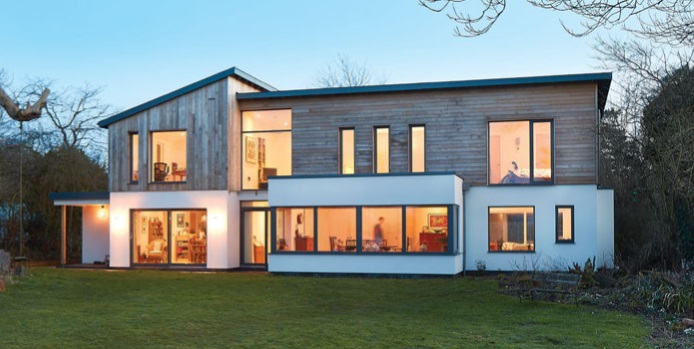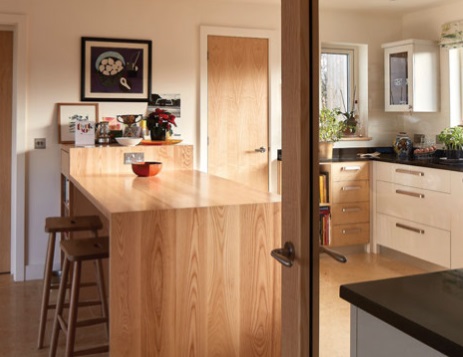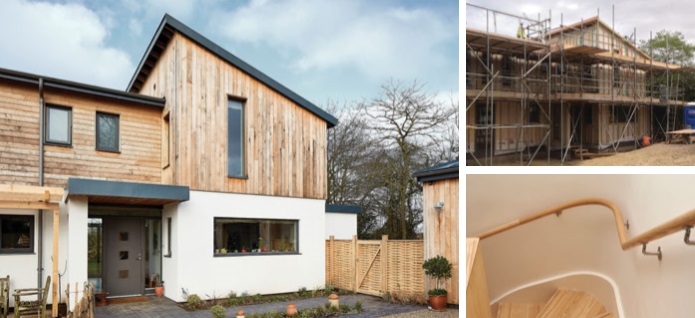Harefield House
Harefield House was an exemplar use of integrated technologies, energy performance and building management system with its prefabricated timber kit construction.
Receiving Commended in the Alan King Award for Excellence in Architectural Technology at the AT Awards 2017, Chris Game MCIAT of Plaice Design Company Limited explains the project.
Our clients had long held the ambition to build their own bespoke house in the grounds of their existing home, known as Becketts, in the village of Norton, Suffolk. The brief called for the design of a contemporary, sustainable detached four bedroom dwelling to provide approximately 200 sq. m of living accommodation, together with a detached double garage.
The new house has been designed to celebrate ‘approach, entrance and arrival’ which is seen as a critical element in the success and re-development of the site. To achieve this we have orientated the house on a north-south axis to create more defined public and private realms and to maximise winter solar gain. Particular emphasis has been placed on creating strong visual and physical links to the garden spaces, particularly the private front garden with attenuation pond, which will enjoy the south sun, while being screened by trees and hedging.
Architecturally, the house has been designed to be respectful to its surroundings, with careful thought given to massing, form and materials. The mono pitch roofs (with their lower eaves and ridge heights) reinforce this sensitive approach by enabling the property to ‘sit down’ in the landscape when viewed from the street, while creating a more dramatic elevation to the rear.
The home is effectively hidden from view along the street, but glimpse/long views are possible along the new driveway.
The proposed dwelling uses a contemporary vernacular to express each elevation. Each elevation has been designed differently to respond to its immediate context. The mass of the house has been expressed as two wings to create an interesting roof line, one roof perpendicular to the other. Due to the close proximity of the clients existing home, the placement of windows were carefully considered in each elevation, ensuring views to the garden and countryside beyond were framed, forming a connection with the cycles of nature in the surrounding gardens and fields, while avoiding overlooking and privacy concerns.
At the front of the house (south), the entrance has been marked by a modern porch canopy structure extruded from the principle elevation. The line of the porch roof is then extruded across the width of the house to form a wooden pergola to control solar glare into the lounge and snug, which in turn casts shadows/patterns onto the rendered walls to further animate the facade. Timber boarding has been added to the new garage to visually tie both buildings together in a harmonious way.
As part of the design process a number of methods of construction were explored and assessed for their suitability. Ultimately off-site pre-manufactured panels were specified as they appeared to offer the best balance in terms of air tightness, construction time, specification and cost.
The panels were supplied by Svenskhomes, which arrived on site pre-insulated (with U-values of 0.16 W/m2K for walls and 0.13 W/m2K for roofs), with air-tightness and breather membranes fitted and windows and doors installed and sealed, which were then craned into position.
The prefabricated dwelling is highly insulated and air tight. This has resulted in a comfortable environment year round with minimal heating demand during the winter months.
The home uses a number of integrated technologies, each one controlled by the Loxone Building Management System, which allows remote access via any wireless device with the app installed. This level of control has enabled the clients to become proactive and knowledgeable in the performance of their home.
Underfloor heating has been installed to both ground and first floors, generated via an air source heat pump and this is supported by a mechanical ventilation heat recovery system.
A 4 KW PV panel array further adds to the sustainability of the dwelling, with each panel incorporating micro inverters, which gains better yields and allows the client to assess the efficiency of each panel. Any spare electricity from the PV array is automatically diverted to an immerSUN unit to heat the hot water.
All surface water for the property discharges into an attenuation wildlife pond, with run-off via an overflow pipe into the adjacent ditch.
As a machine for living, the dwelling is proving very effective and is exceeding all the modelled data stated in the SAP calculations.
Judges’ comments:
The choice of construction, prefabricated timber kit, is perfect for this type of project, enabling the balance of speed and efficiency coupled with an environment control system that ensures that all building systems work together to keep the comfort level exactly how the client wishes. Excellent detailing and on-site control has enabled the high as-built air-tightness of the overall structure, which contributes to low running costs.
This article was originally published in the AT Autumn issue 123.
--CIAT
[edit] Related articles on Designing Buildings Wiki
Featured articles and news
Latest Build UK Building Safety Regime explainer published
Key elements in one short, now updated document.
UKGBC launch the UK Climate Resilience Roadmap
First guidance of its kind on direct climate impacts for the built environment and how it can adapt.
CLC Health, Safety and Wellbeing Strategy 2025
Launched by the Minister for Industry to look at fatalities on site, improving mental health and other issues.
One of the most impressive Victorian architects. Book review.
Common Assessment Standard now with building safety
New CAS update now includes mandatory building safety questions.
RTPI leader to become new CIOB Chief Executive Officer
Dr Victoria Hills MRTPI, FICE to take over after Caroline Gumble’s departure.
Social and affordable housing, a long term plan for delivery
The “Delivering a Decade of Renewal for Social and Affordable Housing” strategy sets out future path.
A change to adoptive architecture
Effects of global weather warming on architectural detailing, material choice and human interaction.
The proposed publicly owned and backed subsidiary of Homes England, to facilitate new homes.
How big is the problem and what can we do to mitigate the effects?
Overheating guidance and tools for building designers
A number of cool guides to help with the heat.
The UK's Modern Industrial Strategy: A 10 year plan
Previous consultation criticism, current key elements and general support with some persisting reservations.
Building Safety Regulator reforms
New roles, new staff and a new fast track service pave the way for a single construction regulator.
Architectural Technologist CPDs and Communications
CIAT CPD… and how you can do it!
Cooling centres and cool spaces
Managing extreme heat in cities by directing the public to places for heat stress relief and water sources.
Winter gardens: A brief history and warm variations
Extending the season with glass in different forms and terms.
Restoring Great Yarmouth's Winter Gardens
Transforming one of the least sustainable constructions imaginable.


























